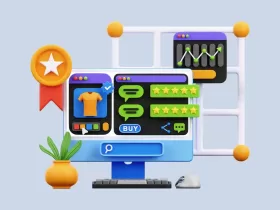Content marketing is more than just a buzzword; it’s a critical component of a successful e-commerce strategy. With the right approach, content marketing can help e-commerce businesses attract, engage, and retain customers, increase sales, and strengthen brand loyalty. In this article, we’ll explore effective content marketing strategies for e-commerce businesses, focusing on how to create and distribute valuable content that resonates with your target audience.
- Why Content Marketing Matters for E-Commerce
- 1. Understanding Your Audience
- 2. Crafting a Content Strategy
- 3. Creating High-Quality, Valuable Content
- 4. Diversifying Content Formats
- 5. Distributing Your Content Effectively
- 6. Measuring Content Marketing Success
- 7. Staying Agile and Adapting to Trends
- Conclusion
Why Content Marketing Matters for E-Commerce
Content marketing involves creating and sharing valuable, relevant, and consistent content to attract and engage a defined audience. For e-commerce businesses, this can translate into increased website traffic, higher conversion rates, and stronger customer relationships. Here are some key reasons why content marketing is essential for e-commerce:
- Builds Brand Awareness: Quality content helps your brand stand out in a crowded marketplace, making it easier for potential customers to discover your products.
- Enhances SEO Efforts: Well-crafted content improves your search engine rankings, making it easier for customers to find your website through organic search.
- Engages and Educates Customers: Informative content addresses customer pain points, answers questions, and provides valuable insights that can influence purchasing decisions.
- Drives Conversions: Content tailored to your audience’s needs and interests can guide them through the sales funnel, turning prospects into loyal customers.
- Strengthens Customer Loyalty: Consistently providing valuable content helps build trust and keeps customers coming back for more.
1. Understanding Your Audience
The foundation of any successful content marketing strategy is a deep understanding of your target audience. Knowing who your customers are, what they value, and how they interact with your brand will help you create content that resonates with them.
Steps to Understand Your Audience
- Create Buyer Personas: Develop detailed profiles of your ideal customers, including demographics, interests, pain points, and buying behaviors. This will help you tailor your content to meet their specific needs.
- Conduct Market Research: Use surveys, social media insights, and analytics tools to gather data on your audience’s preferences and behaviors. This will provide valuable insights into the types of content they engage with most.
- Analyze Competitors: Look at what your competitors are doing in terms of content marketing. Identify gaps and opportunities where you can offer something unique or better.
2. Crafting a Content Strategy
Once you have a clear understanding of your audience, it’s time to craft a content strategy that aligns with your business goals. A well-defined strategy will guide your content creation efforts and ensure consistency across all channels.
Key Components of a Content Strategy
- Set Clear Objectives: Define what you want to achieve with your content marketing efforts. Common goals include increasing website traffic, boosting conversions, enhancing brand awareness, or building customer loyalty.
- Identify Key Content Themes: Determine the main topics and themes that align with your brand and resonate with your audience. These themes should be relevant to your products and address the needs or interests of your customers.
- Develop a Content Calendar: Plan your content with a content calendar that outlines what you will publish and when. This will help you maintain consistency and ensure a steady flow of fresh content.
- Choose Content Formats: Decide on the types of content that will best engage your audience. Popular formats for e-commerce include blog posts, product guides, videos, infographics, and user-generated content.
3. Creating High-Quality, Valuable Content
The success of your content marketing strategy hinges on the quality of your content. It’s not enough to produce content for the sake of it; your content must be valuable, relevant, and engaging to your audience.
Tips for Creating High-Quality Content
- Focus on Value: Always aim to provide value to your audience. Whether you’re educating, entertaining, or inspiring, your content should address the needs and interests of your readers.
- Use Storytelling: Storytelling is a powerful tool for connecting with your audience on an emotional level. Share stories that highlight your brand values, customer experiences, or the journey behind your products.
- Optimize for SEO: Incorporate relevant keywords naturally into your content to improve its visibility on search engines. Pay attention to on-page SEO elements like meta titles, descriptions, headings, and internal links.
- Keep it Engaging: Use visuals, such as images, videos, and infographics, to break up text and make your content more engaging. Include clear calls to action (CTAs) to guide readers toward the next step, whether it’s making a purchase or signing up for a newsletter.
- Leverage User-Generated Content (UGC): Encourage your customers to share their experiences with your products through reviews, photos, or videos. UGC not only builds trust but also provides fresh, authentic content that resonates with potential buyers.

4. Diversifying Content Formats
Diversifying your content formats can help you reach a wider audience and cater to different preferences. Experiment with various types of content to see what works best for your brand and audience.
Popular Content Formats for E-Commerce
- Blog Posts: Blog posts are a versatile format for sharing insights, tips, product guides, and industry news. They help drive organic traffic and position your brand as a thought leader.
- Videos: Video content is highly engaging and can be used for product demonstrations, tutorials, customer testimonials, and behind-the-scenes glimpses. With the rise of platforms like YouTube, TikTok, and Instagram Reels, videos are a must-have in your content arsenal.
- Infographics: Infographics are a great way to present complex information in an easy-to-digest visual format. Use them to showcase product benefits, compare options, or highlight industry trends.
- Ebooks and Guides: In-depth resources like ebooks and guides can establish your brand as an authority in your niche. Offer them as free downloads in exchange for email sign-ups to grow your subscriber list.
- Podcasts: Podcasts are growing in popularity and offer a unique way to connect with your audience. Consider hosting a podcast to share expert interviews, industry insights, or behind-the-scenes stories.
- Email Newsletters: Email remains one of the most effective channels for nurturing customer relationships. Use newsletters to share your latest content, promote products, and offer exclusive deals.
5. Distributing Your Content Effectively
Creating great content is only half the battle; getting it in front of your audience is equally important. An effective distribution strategy will help you maximize the reach and impact of your content.
Content Distribution Channels
- Social Media: Leverage social media platforms like Facebook, Instagram, Pinterest, and LinkedIn to share your content and engage with your audience. Tailor your content to each platform’s strengths and audience preferences.
- Email Marketing: Use your email list to distribute content directly to your subscribers. Segment your list to send targeted content that aligns with the interests and behaviors of different customer groups.
- Search Engine Optimization (SEO): Optimize your content for search engines to increase its visibility in organic search results. Focus on relevant keywords, on-page SEO, and link-building strategies to drive more traffic to your site.
- Paid Advertising: Amplify your content’s reach with paid advertising options like Google Ads, Facebook Ads, and Instagram Ads. Promote high-value content, such as guides or webinars, to attract new leads.
- Influencer Partnerships: Collaborate with influencers in your niche to expand your content’s reach. Influencers can help you tap into new audiences and lend credibility to your brand.
- Content Syndication: Syndicate your content on third-party platforms, such as industry blogs or news sites, to reach a broader audience. This can also help improve your SEO by generating backlinks to your website.
6. Measuring Content Marketing Success
To ensure your content marketing efforts are paying off, it’s essential to track key metrics and analyze performance. This will help you understand what’s working, what needs improvement, and how to refine your strategy over time.
Key Metrics to Track
- Website Traffic: Monitor the number of visitors to your site and which content is driving the most traffic. Use tools like Google Analytics to track page views, bounce rates, and average time on the page.
- Engagement: Measure how your audience is interacting with your content. Look at metrics like social shares, comments, likes, and click-through rates to gauge engagement levels.
- Conversion Rates: Track how well your content is converting visitors into customers. This could include sales, email sign-ups, or other desired actions.
- SEO Performance: Monitor your content’s performance in search engines, including keyword rankings, organic traffic, and backlinks.
- Return on Investment (ROI): Assess the ROI of your content marketing efforts by comparing the cost of content creation and distribution with the revenue generated.
7. Staying Agile and Adapting to Trends
The digital landscape is constantly evolving, and staying agile is key to maintaining a successful content marketing strategy. Keep an eye on emerging trends, such as the rise of AI in content creation, the growing importance of video, and changes in consumer behavior.
Tips for Staying Agile
- Regularly Review and Update Content: Ensure your content remains relevant and up-to-date by conducting regular reviews. Update old content with new information or repurpose it into different formats.
- Experiment with New Formats and Channels: Don’t be afraid to try new content formats or explore new distribution channels. Keep track of performance to see what resonates with your audience.
- Listen to Your Audience: Pay attention to customer feedback, social media comments, and analytics data to understand what your audience wants. Use these insights to inform your content strategy.
- Leverage Technology: Utilize content management tools, analytics platforms, and AI-powered solutions to streamline your content marketing efforts and gain a competitive edge.
Conclusion
Content marketing is a powerful tool for e-commerce businesses looking to attract, engage, and retain customers. By understanding your audience, crafting a solid content strategy, creating high-quality content, and distributing it effectively, you can drive meaningful results for your e-commerce brand.
Stay agile, embrace new trends, and continuously refine your approach to keep your content marketing strategy fresh and effective. With the right tactics and a commitment to delivering value, you’ll be well on your way to building a loyal customer base and achieving long-term success in the competitive world of e-commerce.
Contact usto learn more!





























Leave a Reply